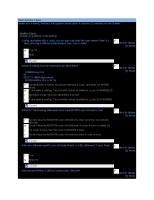Section 6 Quiz Plsql
Test: Section 6 Quiz Review your answers, feedback, and question scores below. An asterisk (*) indicates a correct answe
Views 452 Downloads 31 File size 473KB
Recommend stories
- Author / Uploaded
- Ovie Widiyastuti
Citation preview
Test: Section 6 Quiz Review your answers, feedback, and question scores below. An asterisk (*) indicates a correct answer.
Section 6 Quiz (Answer all questions in this section) 1.Which of the following statements about user-defined PL/SQL records is NOT true?
Mark for Review (1) Points
It is not the same as a row in a database table. It must contain one or more components, but all the components must have scalar datatypes. (*) It can be used as an OUT parameter in a package procedure. It can be a component of another PL/SQL record. It can be defined as NOT NULL. Correct 2.You can store a whole record in a single variable using %ROWTYPE or by creating your own record structure as a type and then declaring a variable of that type.
Mark for Review (1) Points
True (*) False Correct 3.The following code declares a PL/SQL record with the same structure as a row of the departments table. True or False?
Mark for Review (1) Points
DECLARE v_dept_rec departments%ROWTYPE; ... True (*) False Correct 4.Which of the following will successfully create a record type containing two fields, and a record variable of that type? TYPE person_type IS RECORD (l_name VARCHAR2(20), gender CHAR(1)); person_rec person_type; (*) TYPE person_type IS (l_name VARCHAR2(20), gender CHAR(1)); person_rec person_type; TYPE person_type IS (l_name VARCHAR2(20), gender CHAR(1));
Mark for Review (1) Points
person_rec TYPE person_type; TYPE person_type IS RECORD (l_name VARCHAR2(20), gender CHAR(1)); person_rec TYPE person_type; Correct 5.You can use %ROWTYPE with tables and views.
Mark for Review (1) Points
True (*) False Correct Section 6 Quiz (Answer all questions in this section) 6. Which of these PL/SQL data structures could store a complete copy of the employees table, i.e., 20 complete table rows?
Mark for Review (1) Points
An explicit cursor based on SELECT * FROM employees; An INDEX BY table of records (*) A record An INDEX BY table Correct 7. Which of the following methods can be used to reference elements of an INDEX BY table? (Choose three.)
Mark for Review (1) Points
(Choose all correct answers) COUNT (*) DROP EXISTS (*) FIRST (*) PREVIOUS Correct 8. In an INDEX BY table of records the record can be _______________________.
a user-defined record %ROWTYPE (*) Either one. Incorrect. Refer to Section 6 Lesson 2.
Mark for Review (1) Points
9. To declare an INDEX BY table, we must first declare a type and then declare a collection variable of that type. True or False?
Mark for Review (1) Points
True (*) False Correct 10.An INDEX BY TABLE type can only have one data field.
Mark for Review (1) Points
True (*) False Correct Section 6 Quiz (Answer all questions in this section) 11.What is the largest number of elements (i.e., records) that an INDEX BY table of records can contain?
Mark for Review (1) Points
None of these. Many millions of records because a BINARY_INTEGER or PLS_INTEGER can have a very large value (*) 100 4096 32767 Correct 12.Which of the following successfully declares an INDEX BY table of records which could be used to store copies of complete rows from the departments table?
Mark for Review (1) Points
DECLARE TYPE t_depttab IS TABLE OF departments%ROWTYPE INDEXED BY NUMBER; DECLARE TYPE t_depttab IS TABLE OF departments%TYPE INDEX BY BINARY_INTEGER; DECLARE TYPE t_depttab IS INDEX BY TABLE OF departments%ROWTYPE INDEX BY BINARY_INTEGER; DECLARE TYPE t_depttab IS TABLE OF departments%ROWTYPE INDEX BY BINARY_INTEGER; (*) Correct 13.An INDEX BY TABLE primary key cannot be negative.
Mark for Review (1) Points
True False (*) Correct 14.Identify the valid collection types:
Mark for Review (1) Points
(Choose all correct answers) INDEX BY TABLE OF RECORDS (*) INDEX BY TABLE OF ROWS INDEX BY TABLE (*) INDEX BY VIEW Correct 15.Which of these PL/SQL data structures can NOT store a collection?
An INDEX BY table indexed by BINARY_INTEGER An INDEX BY table of records An INDEX BY table indexed by PLS_INTEGER A PL/SQL record (*) Correct
Mark for Review (1) Points









